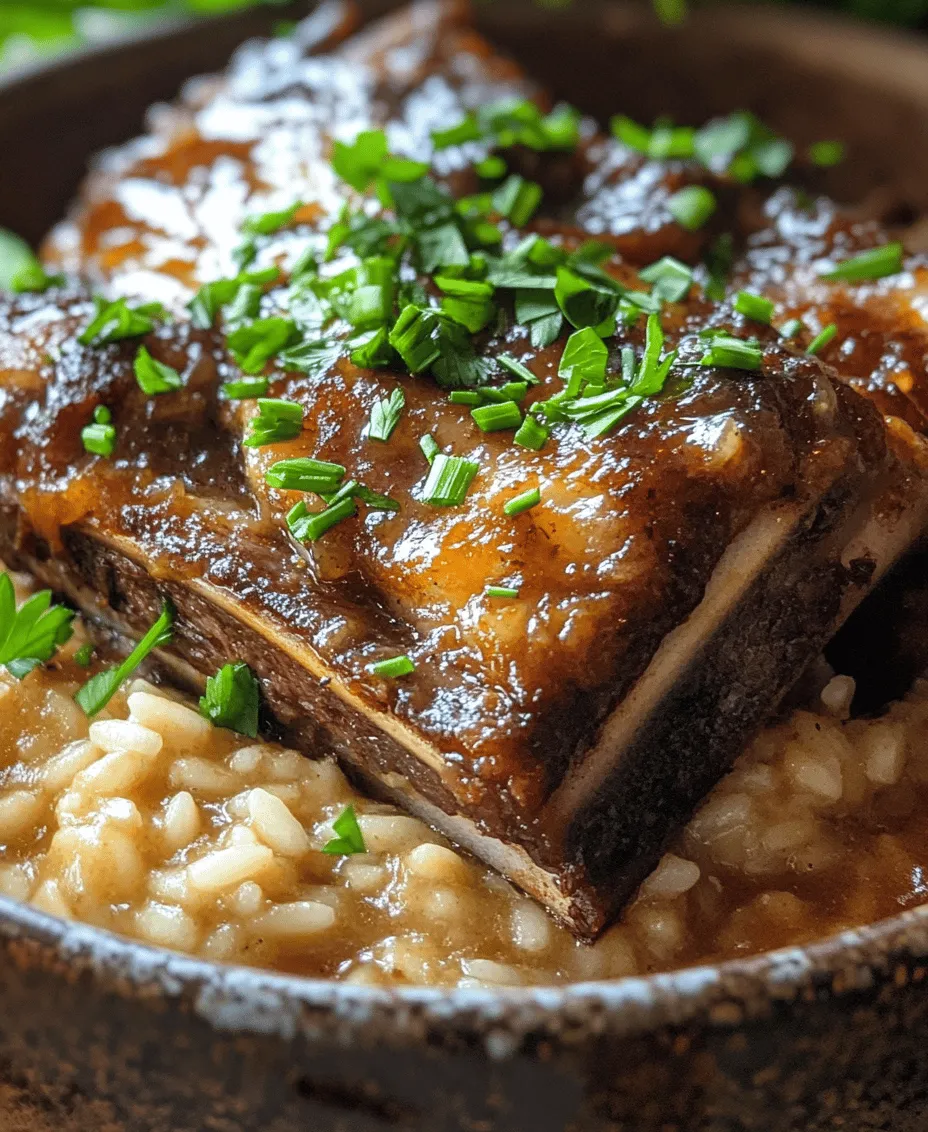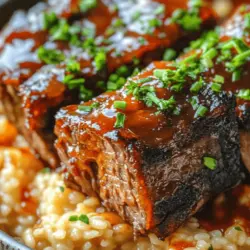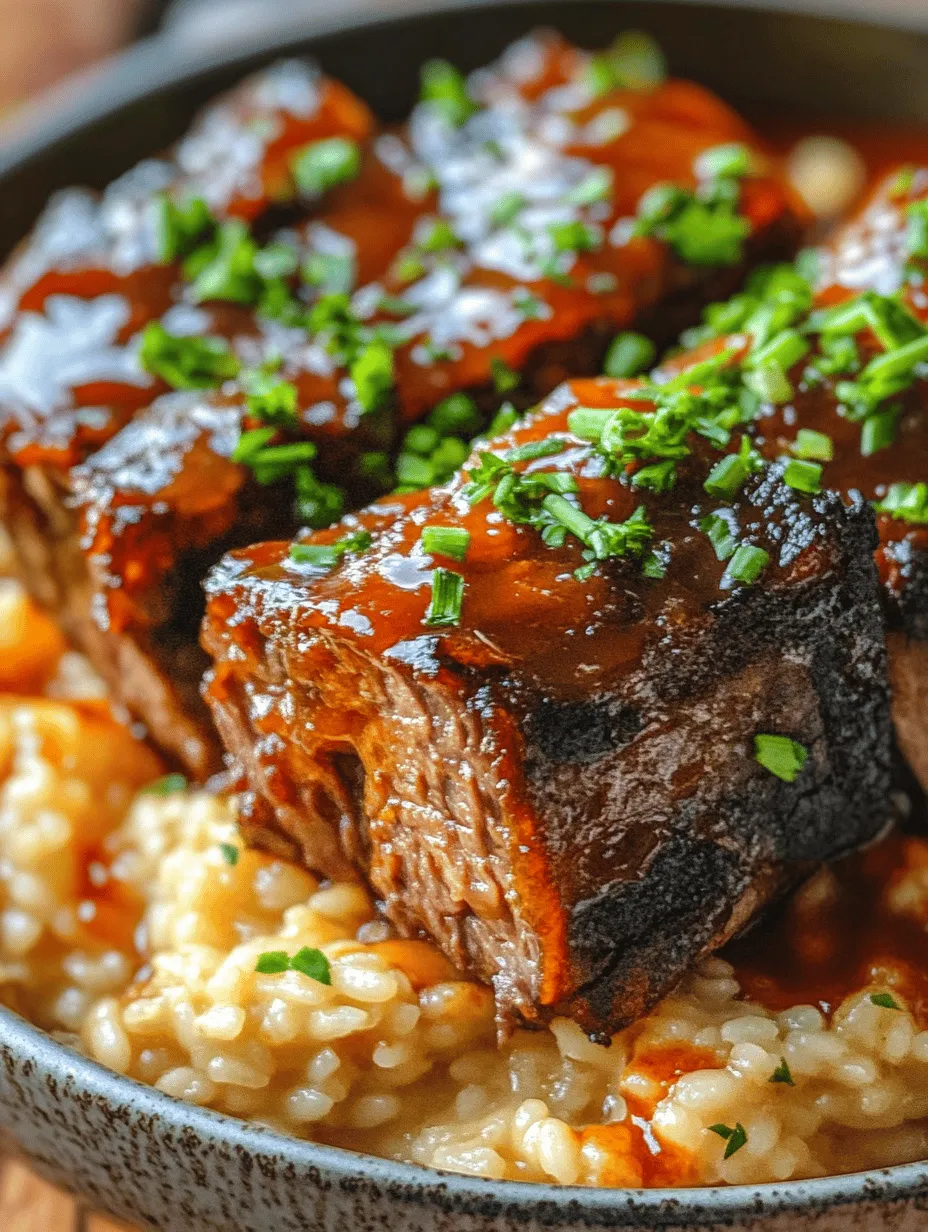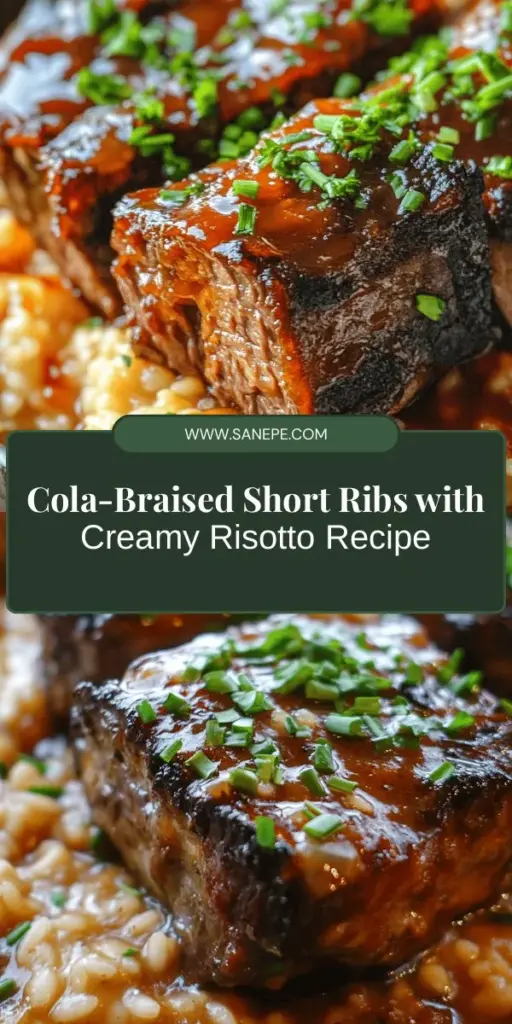Introduction
If you are searching for a dish that combines deep, rich flavors with a touch of sweetness and an irresistibly creamy texture, look no further than succulent short ribs slow-cooked in cola, served alongside creamy Parmesan risotto. This unique recipe marries the savory depth of beef short ribs with the unexpected sweetness of cola, creating a comforting meal that is sure to impress family and friends alike.
Slow cooking has a special place in the culinary world, revered for its ability to transform simple ingredients into luxurious dishes that burst with flavor. The magic of slow-cooked meals lies in the way they allow flavors to meld and develop over time, resulting in tender meat that falls off the bone and a sauce that is rich and complex. In this recipe, the cola not only enhances the taste but also tenderizes the beef, creating a dish that is both indulgent and satisfying.
In this article, you will learn how to prepare these mouthwatering short ribs, the importance of each ingredient, and how to make the perfect creamy Parmesan risotto that complements the dish beautifully. Prepare your taste buds for an unforgettable culinary experience as we dive into the details of this incredible recipe.
Understanding the Ingredients
Key Ingredients Overview
Before we roll up our sleeves and get into the cooking process, it’s essential to understand the key ingredients that make this dish so special. The star of the show is undoubtedly the beef short ribs. Known for their rich marbling and robust flavor, short ribs are a cut of meat that benefits immensely from slow cooking. This method allows the connective tissue to break down, resulting in incredibly tender and flavorful meat that is hard to resist.
The second significant player in this recipe is cola. While it may seem unconventional to use a soda in a savory dish, cola brings a unique combination of sweetness and acidity that enhances the natural flavor of the beef. The sugar in the cola caramelizes during the cooking process, creating a rich, glossy sauce that adds depth and complexity to the dish.
Lastly, we have the creamy Parmesan risotto, which serves as the perfect accompaniment to the short ribs. Risotto, made with arborio rice, is known for its creamy consistency and ability to absorb flavors, making it an ideal canvas for the rich sauce from the short ribs. The addition of Parmesan cheese not only elevates the flavor but also adds a luxurious creaminess that perfectly balances the savory notes of the beef.
Importance of Beef Short Ribs
When choosing short ribs for this recipe, look for well-marbled cuts, as the fat will render during cooking, infusing the meat with flavor and moisture. The ideal cut is typically cut about two inches thick, allowing for plenty of surface area to develop a crust when seared. The tenderness achieved through slow cooking makes short ribs a favorite among meat lovers, and their rich, beefy flavor pairs wonderfully with a variety of sides, particularly the creamy risotto we’ll be preparing.
Role of Cola in the Cooking Process
Cola is more than just a sweetener in this recipe; it plays a crucial role in the cooking process. The sugars in cola caramelize as the short ribs slow cook, creating a beautiful glaze that coats the meat. Additionally, the acidity in cola helps to tenderize the beef, breaking down the fibers and resulting in a melt-in-your-mouth experience. As the cola reduces, it intensifies in flavor, transforming into a luxurious sauce that is both sweet and savory.
Discussion of Creamy Parmesan Risotto
Now, let’s talk about the creamy Parmesan risotto that will accompany our short ribs. Risotto is a staple of Italian cuisine, made by slowly cooking arborio rice in broth until it becomes tender and creamy. The key to perfect risotto is patience and constant stirring, which releases the starches in the rice, creating that signature creamy texture.
In this recipe, the richness of the Parmesan cheese elevates the risotto, making it a perfect pairing for the bold flavors of the cola-braised short ribs. The creaminess of the risotto complements the tender meat and sauce, ensuring that every bite is a harmonious blend of flavors.
Preparation of Short Ribs
Steps to Prepare the Short Ribs for Cooking
Now that we’ve set the stage, it’s time to prepare our short ribs for slow cooking. The first step is to remove the short ribs from the refrigerator and let them come to room temperature. This will help them cook more evenly.
Next, pat the ribs dry with paper towels to remove excess moisture. This step is crucial, as it ensures that the meat will sear properly, creating a beautiful crust that enhances the flavor. Once dried, season the ribs generously with salt and freshly cracked black pepper. Don’t be afraid to use a liberal hand with the seasoning; this is your chance to infuse the meat with flavor right from the start.
Importance of Seasoning and Browning
Seasoning is vital in any recipe, but it becomes even more critical when dealing with cuts of meat like short ribs. The seasoning not only adds flavor but also helps to create a delicious crust during the searing process. Browning the short ribs is an essential step that enhances the overall depth of flavor in the dish.
To achieve this, heat a large, heavy-bottomed pot or Dutch oven over medium-high heat. Add a couple of tablespoons of oil (vegetable or canola oil works well) and allow it to heat until shimmering. Carefully place the seasoned short ribs in the pot, making sure not to overcrowd the pan. You may need to work in batches. Sear the ribs for about 3-4 minutes on each side, or until they develop a deep brown crust. This process not only adds flavor but also creates fond at the bottom of the pot, which will contribute to the sauce later.
Searing Technique: Tips for Achieving a Perfect Crust
To achieve that perfect crust, remember these tips:
1. Don’t Rush the Process: Allow the ribs to sear without moving them around too much. This will enable a proper crust to form.
2. Avoid Overcrowding: If you place too many ribs in the pot at once, the temperature will drop, and you’ll end up steaming rather than searing the meat. Work in batches if necessary.
3. Patience is Key: Let the meat develop a crust before flipping it. If you try to turn it too soon, it may stick to the pan.
Once the short ribs are beautifully browned on all sides, transfer them to a plate and set them aside while you prepare the sauce.
Creating the Cola Sauce
Explanation of the Sauce-Making Process
With the short ribs seared to perfection, it’s time to make the cola sauce that will bring this dish together. In the same pot where you browned the short ribs, you’ll want to add a touch more oil if needed, followed by chopped onions and minced garlic. Sauté these aromatics over medium heat until they become translucent and fragrant, about 3-4 minutes. This step is crucial for developing the foundational flavors of the sauce.
Importance of Sautéing Onions and Garlic
Sautéing the onions and garlic releases their natural sugars and enhances their flavors, making them sweeter and more aromatic. The caramelization of these ingredients will create a flavorful base for the cola sauce, ensuring that every bite of short rib is bursting with flavor.
Breakdown of Cola Sauce Ingredients
To create the cola sauce, you will need the following ingredients:
– 1 can (12 ounces) cola
– 1 cup beef broth
– 2 tablespoons Worcestershire sauce
– 2 tablespoons apple cider vinegar
– Salt and black pepper to taste
Each ingredient plays a vital role in the depth of flavor. The cola adds sweetness, while the beef broth provides a savory backbone. Worcestershire sauce contributes umami, and apple cider vinegar adds a touch of acidity that balances the sweetness of the cola.
Tips for Achieving the Right Consistency and Flavor Balance
After sautéing the onions and garlic, pour in the cola, beef broth, Worcestershire sauce, and apple cider vinegar. Stir to combine and scrape the bottom of the pot to loosen any flavorful bits stuck to the bottom. Allow this mixture to come to a simmer, then return the browned short ribs to the pot, nestling them into the sauce.
Cover the pot and reduce the heat to low, allowing the ribs to cook slowly for several hours. The longer you cook the ribs, the more tender they will become, and the flavors will deepen. Check the sauce periodically, and if needed, add more beef broth to maintain the desired consistency.
By the end of this slow cooking process, you will have beautifully tender short ribs bathed in a rich, savory cola sauce that is perfect for drizzling over the creamy Parmesan risotto.
In the next section, we will delve into the process of slow cooking the ribs to perfection, ensuring that every bite is an explosion of flavor and tenderness. Stay tuned as we continue this culinary journey!

Importance of Slow Cooking in Developing Flavor and Tenderness
Slow cooking is an essential technique for achieving deep flavors and tender textures, especially when it comes to beef dishes like succulent short ribs. The low and slow method allows the connective tissues in the meat to break down gradually, resulting in a melt-in-your-mouth experience. This process enhances the flavor profile of the dish, as the ingredients have time to meld together, infusing the meat with the rich, sweet notes of cola and the aromatic spices used in the recipe.
Ideal Settings and Timing for the Slow Cooker
When using a slow cooker for your short ribs, it’s crucial to find the right settings and timing to ensure optimal results. Most slow cookers have two primary settings: low and high. For this recipe, using the low setting is recommended, which typically cooks for about 8 hours. This extended cooking time allows the flavors to develop fully and ensures the meat becomes incredibly tender.
If you’re short on time, you can use the high setting, which will cook the ribs in approximately 4 hours. However, for the best results, especially for tougher cuts of meat like short ribs, the low setting is always preferred. Remember to check the internal temperature of the meat; it should reach at least 190°F to ensure the collagen has broken down sufficiently.
Benefits of Low and Slow Cooking Methods for Beef
Low and slow cooking methods, such as braising or using a slow cooker, are particularly beneficial for tougher cuts of beef. These methods allow for a more gradual cooking process, which not only enhances the meat’s flavor but also ensures it remains moist. As the meat cooks slowly, it absorbs the cooking liquid, which in this case, is a delightful mixture of cola, broth, and spices.
Additionally, the long cooking time helps to render the fat in the meat, which adds richness to the dish. The result is beef that is not only tender but also infused with layers of flavor that make each bite a delectable experience.
Signs That the Short Ribs are Perfectly Cooked and Ready to Serve
Knowing when your short ribs are perfectly cooked can be determined by a few telltale signs. Firstly, the meat should be tender enough to fall off the bone with minimal effort. The connective tissues should have broken down completely, resulting in a luscious texture.
Secondly, the color of the meat should be a deep, rich brown, indicating that it has caramelized and absorbed the flavors from the cooking liquid. Lastly, the aroma should be mouthwatering, with a balance of sweetness from the cola and savory notes from the spices. If you notice these signs, your short ribs are ready to be served alongside the creamy Parmesan risotto.
Making the Creamy Parmesan Risotto
Step-by-Step Guide to Preparing Risotto
Risotto is a classic Italian dish known for its creamy texture and rich flavor. Making risotto requires a bit of attention but is well worth the effort. Here’s how to prepare a delightful creamy Parmesan risotto to accompany your succulent short ribs:
1. Ingredients Preparation: Gather your ingredients, including Arborio rice, chicken or vegetable broth, onion, garlic, butter, white wine, grated Parmesan cheese, and fresh herbs like parsley for garnish.
2. Sauté Aromatics: In a medium saucepan, melt 2 tablespoons of butter over medium heat. Add finely chopped onion and garlic, sautéing until they become translucent and fragrant, about 2-3 minutes.
3. Toast the Rice: Add 1 cup of Arborio rice to the pot, stirring frequently for about 2 minutes. This step helps to toast the rice, enhancing its flavor and preparing it for the gradual addition of broth.
4. Deglaze with Wine: Pour in ½ cup of white wine, stirring continuously until the wine has nearly evaporated. This step adds a depth of flavor to the risotto.
5. Add Broth Gradually: Begin adding warm broth, one ladle at a time, to the rice. Stir the mixture frequently, allowing the rice to absorb the liquid before adding more. This gradual addition is essential for creating that creamy texture risotto is known for.
6. Cook Until Al Dente: Continue this process for about 18-20 minutes, or until the rice is tender but still has a slight bite (al dente). You may need about 4-5 cups of broth, depending on the desired creaminess.
7. Finish with Parmesan: Once the rice is cooked to perfection, remove the pot from heat and stir in ½ cup of grated Parmesan cheese, along with the remaining 2 tablespoons of butter. This will enhance the creaminess and flavor of the risotto.
8. Season to Taste: Season with salt and pepper to taste, adjusting the flavors as necessary.
Explanation of Arborio Rice and Its Role in Creating Creamy Texture
Arborio rice is a short-grain rice variety that is traditionally used for making risotto. Its unique starch content is what gives risotto its signature creamy texture. As Arborio rice cooks, it releases starch, which thickens the cooking liquid and creates a luscious, velvety consistency. This characteristic makes it ideal for absorbing flavors from the broth and other ingredients, resulting in a rich and satisfying dish.
Importance of Gradual Broth Addition and Constant Stirring
The key to achieving the perfect risotto lies in the method of cooking. Gradually adding broth and stirring constantly allows the rice to release its starch while absorbing the liquid. This slow process is what creates the creamy texture that risotto is famous for. If you add all the broth at once, you risk ending up with a soupy mixture instead of the desirable creamy consistency.
Tips for Achieving the Perfect Al Dente Texture and Rich Flavor
– Use Warm Broth: Always use warm broth when making risotto. Cold broth will lower the cooking temperature, prolonging the cooking time and potentially affecting the final texture.
– Don’t Rush the Process: Take your time with the gradual addition of broth. This patience is what transforms Arborio rice into a creamy masterpiece.
– Taste as You Go: Regularly taste the risotto as it cooks to ensure it reaches the perfect al dente texture. You want the rice to be tender but still firm to the bite.
– Finish Strong: Stir in the Parmesan cheese and butter off the heat to avoid overcooking and to maintain the creamy texture.
Serving Suggestions
Presentation Tips for an Appealing Dish
Serving your succulent short ribs with creamy Parmesan risotto is not only delicious but also an opportunity to showcase your culinary skills. Presentation plays a vital role in enhancing the dining experience. Here are some tips to create an appealing dish:
– Choose the Right Plate: Opt for a wide, shallow bowl or a large plate to allow for a beautiful arrangement of the ribs and risotto.
– Layering: Start by placing a generous scoop of risotto in the center of the plate. This will serve as the base for the short ribs.
Plating Techniques: How to Arrange Ribs and Risotto for Visual Appeal
– Arrange the Ribs: Place two or three pieces of short rib on top of the risotto, leaning them slightly to create height and visual interest.
– Sauce Drizzle: Use a spoon to drizzle some of the cooking liquid over the ribs and risotto, adding a glossy finish.
– Garnish: Finish with a sprinkle of freshly chopped parsley or chives for a burst of color and freshness.
Suggested Garnishes and Their Flavor Contributions
– Fresh Herbs: Chopped parsley or basil adds a touch of brightness and contrast to the rich flavors of the dish.
– Parmesan Shavings: A few shavings of fresh Parmesan cheese can elevate the dish, adding an extra layer of flavor and elegance.
– Balsamic Reduction: A drizzle of balsamic reduction can provide a tangy contrast to the sweetness of the cola and enhance the overall flavor profile.
Nutritional Information
Overview of the Nutritional Benefits of This Dish
This succulent short ribs and creamy Parmesan risotto dish not only delivers on flavor but also offers various nutritional benefits. Short ribs, while rich in flavor, provide essential nutrients such as protein, iron, and zinc, which are crucial for muscle growth and immune function. The use of fresh ingredients in the risotto, including onions and garlic, adds vitamins and antioxidants, contributing to overall health.
Balancing Comfort Food with Nutritional Value
While this dish is undeniably comfort food, it can still be part of a balanced diet. The key is moderation and balance. Enjoying a serving of short ribs paired with creamy risotto can be a satisfying meal, especially when complemented by a side of vegetables or a fresh salad to add fiber and vitamins.
Discussion on Portion Control and Serving Sizes
When enjoying this rich dish, portion control is essential. A typical serving size for short ribs is around 4-6 ounces, while a serving of risotto should be about 1 cup. By being mindful of serving sizes, you can savor the flavors while maintaining a healthy lifestyle.
Conclusion
In summary, the succulent short ribs slow-cooked in cola paired with creamy Parmesan risotto is a dish that embodies the essence of comfort food. The slow cooking method ensures the beef is tender and flavorful, while the risotto provides a rich, creamy accompaniment that takes the dish to new heights. Not only is this meal a joy to prepare, but it also offers a delightful dining experience that will impress your family and friends.
We encourage you to try this recipe in your kitchen and savor the incredible flavors that result from the combination of these two classic dishes. As you take the time to slow cook and create this meal, you’ll discover the joy of cooking and the satisfaction of serving a dish that is both comforting and memorable. Embrace the process, enjoy each step, and relish the flavors in every bite.


